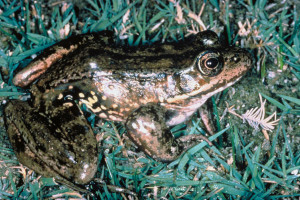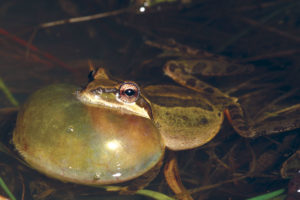
On a cold spring night at Mori Point in Pacifica, the pounding rain has finally stopped. Clouds pull away, revealing a half moon and a glimpse into houses on the nearby hills. It casts a reflection into the small pond where two San Francisco State graduate students, Tarah Haslett and Carolyn Schwartz, stand motionless. Wearing waders and headlamps, recorders strapped to their chests, they listen intently through the distant waves, the far-off traffic.
And then, almost underfoot, very loud: “Rib-bit.”
Haslett extends a large microphone and waits for a second signal. Then she slowly casts her light on the grasses at the water’s edge, slowly wades in to her waist, slowly reaches out, and grabs.
“Got him,” she says.
It’s a tiny frog for such a large noise. Not much bigger than a quarter, Pacific chorus frogs (Hyliola or Pseudacris sierra) are deep green with dark stripes over eyes and back. Common up and down the west coast of the United States, Canada, and Baja, Mexico, chorus frogs have many charms. On males, a translucent throat balloons out to broadcast croaks. Long toes with tips like suction cups make for easy climbing. (Another common name is “Pacific treefrog.”) And they can change color, sliding between green and brown, a camouflaging skill. But for Haslett and Schwartz tonight, it is all about the call. Who is making it. Who is hearing it. How it fits this particular urban niche.
To human ears, the call is simple and familiar, the generic indication of “frog.” In fact, Hollywood often uses Pacific chorus frogs as background noise, no matter where a movie is set. (Greatly to the irritation of the IMDb user who created a list of “Pacific Treefrog Calling Sounds Used Incorrectly in Movies,” with examples from Indiana to India.) It can also be annoyingly loud, prompting complaints like that of a Concord woman who wrote to the Mercury News to say frogs were keeping her daughter up at night.
Frog noises in general can seem mundane, compared to fancy ads like a meadowlark’s trill. In her poem in praise of being Nobody, Emily Dickinson writes:
I’m Nobody! Who are you? Are you – Nobody – too? Then there’s a pair of us! Don’t tell! they’d advertise – you know! How dreary – to be – Somebody! How public – like a Frog – To tell one’s name – the livelong June – To an admiring Bog!
But for a male frog wanting a mate, it is vitally important to be Somebody, to stand out, to be heard in his declarations that he is the One, for listeners to glean his meaning.
“Females will use these calls to make decisions about mating: Is this a male from my species? Is this a good, high-quality male?” says Alejandro Vélez, the S.F. State University professor overseeing this research study. He adds that males are also paying attention, making judgments. “They don’t want males to be too close to them. They’re spacing themselves out in the pond. In some species they can assess if the other male is big or is small and try to avoid a fight.”
Such meanings can get lost if the calls are drowned out. These Pacific chorus frogs live right in the middle of a noisy city. As urban areas grow denser and louder, they have the potential to disrupt animal lives in all kinds of ways, many of them sound-related. A jackhammer at a construction site can obscure the warning of a ground squirrel trying to escape a red-tailed hawk. Sexual invitations get lost in the squeal of brakes. And territorial claims are overcome by the whoosh of light rail.
“Human noise pollution can very easily be overlooked when thinking about conservation since you can’t see it,” Haslett says. But the effects traverse the globe, from whales to crickets. “You can’t go to a single ecosystem that hasn’t been affected by it.”
So how do wild animals that remain make themselves understood? Particularly those, like these frogs, whose lives are defined by sound? Those who, faced with a pond with many kinds of frogs and toads bellowing, piping, and croaking, perhaps near a babbling brook or a railroad track, still need to get their message across? This is at the heart of the questions Haslett, Schwartz, and Vélez are trying to answer, broadening our understanding of communication strategies, one wriggling captive after another.
Species all over the world are adapting to the urban soundscape. Free-tailed bats on natural gas fields in New Mexico narrow the bandwidth of their echolocation. Cardinals near cities in Ohio lengthen their songs. Long-term studies in the Bay Area show that white-crowned sparrows sing at a higher frequency than rural counterparts so they don’t compete with traffic noise. Cities often carve up habitat, with roads and pavement isolating green spaces, creating the opportunity for distinct strategies, new behaviors, and evolutionary pathways to develop. The white-crowned sparrow research tracks how different sparrow neighborhoods—Union Square, the Presidio, the East Bay—produce distinct dialects.
For Vélez, who has studied frogs his entire career, frogs are the ideal subjects for issues of fraught communication. In college in Colombia, taking an animal behavior class, he was struck by the acoustic lives of these amphibians and the questions they posed about making sense of cacophony.
“There are over 7,000 species of frogs and toads, and they are among the most vocal vertebrates,” Vélez says. Information encoded in the calls prompts a female to choose one mate rather than another, launching her reproductive trajectory. “In some cases, females must make these decisions in very noisy environments with hundreds of males of different species calling.”
Like bats and birds, frogs have been documented changing their behavior in response to city life. In Taipei suburbs in Taiwan, male Mientien treefrogs prefer to call from roadside concrete drainages rather than rocks or tree stumps, according to a recent study. The echoey concrete makes their calls louder and longer, giving their signal extra boom. Poison frogs on the slopes of the Andes that live by a road traversed by heavy vehicles call less when the truck noise is loudest. Túngara frogs in Panama City, Panama, make mating calls that are more elaborate than those of frogs that live in the forest, adding additional “chucks.” Both rural and urban females like these calls best.
Intrigued by the possibilities, Vélez joined the lab of his animal behavior professor. Since then, he’s recorded the chirping of brilliant-thighed poison dart frogs in Colombian forests and analyzed the buzzy trills of Cope’s gray treefrogs in Minnesota swamps. And now, after moving to the Bay Area, he’s listening to Pacific chorus frogs in California ponds.
At first, he focused on decoding frog messages. Their simplicity, apparently, is an illusion. Pacific chorus frog males produce several songs—there’s a two-part call (rib-bit or krek-ek), which sounds a bit lackadaisical and, when males all call together, creates a river of sound that draws females to the mating grounds. It’s like the music pouring from the dance club over the sidewalk and throughout the neighborhood, broadcasting news of a hot spot. The two-part call, which doesn’t have much variation, lets the females identify males as the right species, determine if the club is worth their time.
But once the female is close, the male needs an individual pickup line, one to announce himself as “Somebody.” This is the one-part call (krek-krek-krek-krek) that, with a machine-gun urgency, declares a frog’s desirability, and it varies from frog to frog. “Sexier” calls are lower frequency, more rapid, and require more effort than less alluring ones. Females also seem to prefer leaders, those that launch a round of song, rather than those who join in later.
Once the female makes her choice and approaches, the male climbs on her back and grasps her with sticky toe pads. Then they go off, like the pair in the opening of Dickinson’s poem, to be Nobody together, at least for the few moments until the eggs have been laid on a promising twig or stem and fertilized.
With this new study, Vélez and his students are asking, what kind of changes is San Francisco prompting? “Are our frogs following those same patterns recorded in birds, for example, in which they change their calls, probably shifting to higher frequencies?” Vélez asks. Or are they making other alterations, calling louder or longer or faster? And do these changes have a cost?
To figure this out, Haslett and Schwartz are recording frogs at eight study sites, some urban and loud, like the west-of-bayfront property near the San Francisco airport, with jets roaring overhead, some rural and quiet, like Point Reyes, and some rural and loud, like Mori Point with the crashing surf. Naturally noisy sites are important because they also prompt evolution and adaptation. For example, male concave-eared torrent frogs in China that live in rushing streams issue ultrasonic invitations that stand out from the raucous splashes. And glass frogs near waterfalls in Ecuador wave a foot to help attract attention. Does city noise prompt different strategies?
It’s a brief, intense field season, of late nights, deep mud, five-hour waits for frogs that never appear, and a croaking that rings in the ears for hours after. But the S.F. State researchers are hoping to see what these frogs tell us about the nature of cities and maybe offer a glimpse of the future.

Back on the pond bank in a tangle of vegetation, Haslett measures and weighs the frog to be sure differences in vocalizations aren’t just related to differences in size. Larger males often call at lower frequencies, something females appreciate. But that is one aspect of frog social life that cities may be upending.
Earlier, waiting in the car for a pause in the rain (good for frogs, bad for recording equipment) and thinking about all those midnights spent searching for frogs in hidden city waterways, I’d asked, “So, what’s the most surprising thing that you’ve seen?”
Haslett and Schwartz looked at each other. An awkward silence, then a barking laugh.
“I don’t know if you want to know,” Haslett said.
“Surprising things related to frogs and your study,” I said, amending the question. “How about that?”
After a moment’s pause, Schwartz mentioned that, anecdotally, it seemed some frogs in the noisiest places were littler than rural ones. “At SFO there were a lot of small ones, teeny little ones that we couldn’t bring back because we have a size limit.” Smaller bodies could create higher-frequency noise, able to rise above the rush of the planes. Given a choice between an audible call or a larger body, which will females prefer?
As Haslett finishes up measuring one frog, and then another, Schwartz records the temperature of the air and the water. Temperature, too, can alter calls, speeding them up or slowing them down. While the researchers take some frogs back to the lab for further testing, right now they just record, document, and let this bunch go.
Schwartz kneels in the reeds, and the frog jumps off her finger. The one in Haslett’s hand pauses a moment, moves a sticky foot, and then, with a nudge, goes.
And immediately, loud, right from where he landed:
“Rib-bit!”

The next day, in the lab at S.F. State, the second half of the experiment gets underway. Haslett pulls out a food storage container labeled with the date and “male Pt Reyes” and puts it on a long table stacked with boxes of wildlife acoustic supplies and shotgun microphones.
Unlike the many studies on altered urban wildlife howls, songs, and chirps, this one also focuses on the audience. “For effective communications to take place you have those who produce the sounds and but then also those who must listen,” Vélez says. “A lot has been done on how the signals or vocalizations change, but we don’t know much about how the receiver is changing or coping with this problem.” Listeners need to pull the signal from the noise, the vital message from the meaningless chatter, a challenge known as “the cocktail party problem.”
Haslett moves the frog from the container to a beige soundproof booth, like one where you might get a hearing test, but smaller and with a froggier smell. A speaker projects noises at multiple frequencies, one after the other. Electrodes on the frog’s skull allow researchers to see what the animal is hearing, recording when the brain’s auditory pathway responds to a given noise. Frog ears are most sensitive to the frequencies of the call of their own species. Will those from urban areas respond more strongly to higher-frequency calls, the ones that don’t compete with low-frequency human noise? Haslett’s early results from last year, comparing Presidio frogs to East Bay frogs, indicate they might.
She broadcasts the first sound, the highest frequency at the loudest level, and studies the resulting audiogram on the computer. No response. But as the tones get lower, inching into the Pacific chorus frog’s prime range, distinct blips appear. Later, Haslett will play tones with other sounds, to see how effectively the frogs from different populations pull a message from background noise. Eventually, researchers plan to also look for structural changes in the ear itself, to see if the city is reshaping it.
Haslett settles in for a long session. It can take three hours to run all the tests.
After that, the frog’s work is done. “We pull them out of the chamber, give them some time to recover,” says Haslett. Then the students drive this one and others in the cohort back to a Point Reyes pond and let them get back to business.



.jpg)
